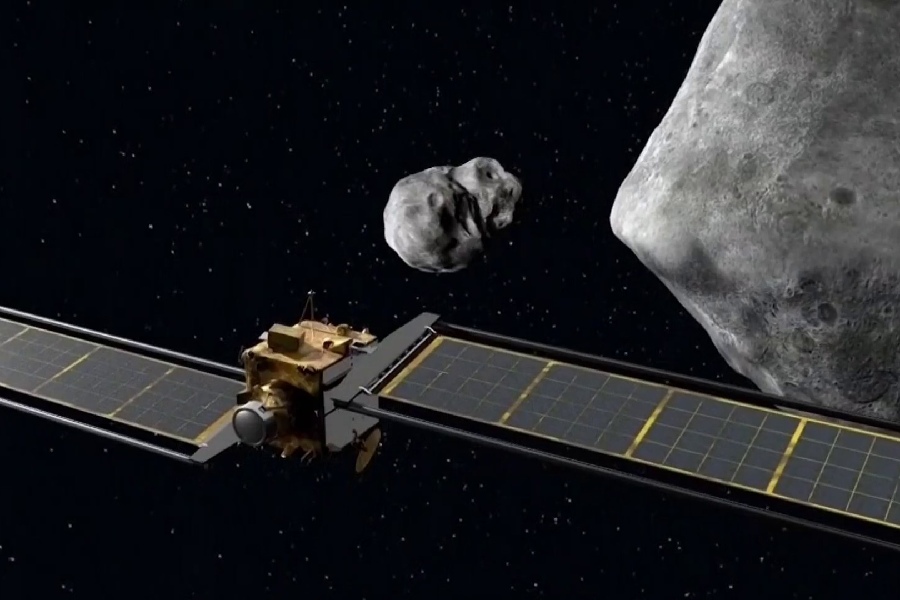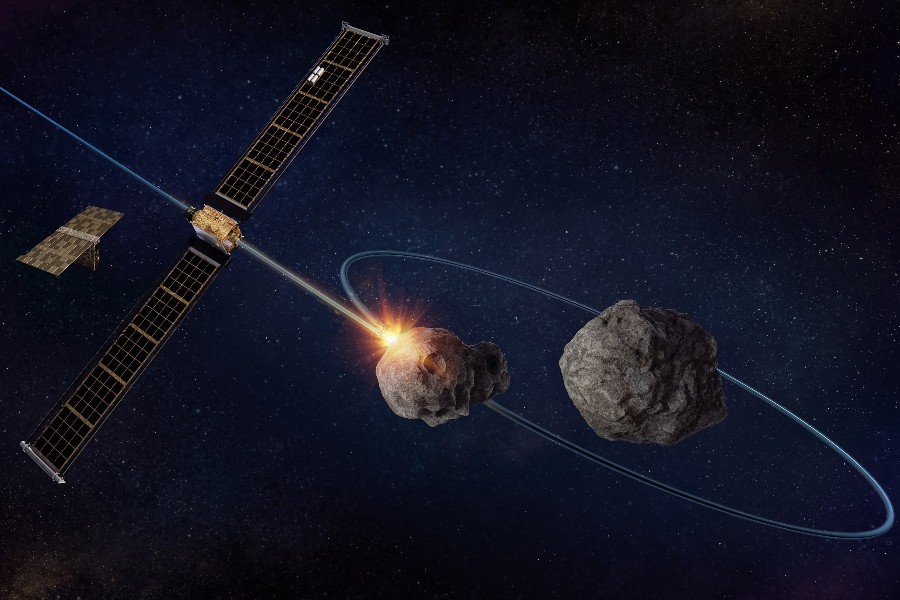Imagine hurtling a spacecraft at over 14,000 miles per hour straight into the cosmos, colliding with a celestial object millions of miles from Earth. Sounds like a scene from a sci-fi blockbuster, doesn’t it? But what did NASA take on this experiment? Why did NASA crash into an asteroid?
This audacious cosmic crash wasn’t fiction – it was NASA’s dramatic gambit to test something that could one day protect our planet from catastrophe.
In a pioneering maneuver last year, the space agency took an unprecedented step by intentionally sacrificing a robotic impactor against its target. But why would NASA want to crash a spacecraft into an asteroid? Why did NASA carry out such a bizarre and risky move?
In a pioneering maneuver last year, the space agency intentionally sacrificed a robotic impactor to alter the orbit of Dimorphic, a harmless moonlet circling the asteroid Didymos.
In this article, we’ll examine the groundbreaking DART mission that made this cosmic crash possible. We’ll explore the techniques for asteroid deflection and assess the reasons for this crash. Join us as we uncover the truth behind this man-made event in space.

Why Did NASA Crash into an Asteroid?
NASA’s mission to crash into an asteroid, termed DART (Double Asteroid Redirection Test), aimed to test planetary defense techniques. The crashing into an asteroid was the first experiment toward saving humanity from any potential asteroid coming our way. Launched in 2021, DART collided with the moonlet of a distant binary asteroid system in 2022.
The goal was to assess the feasibility of deflecting potentially hazardous asteroids away from Earth’s path. Such tests help refine strategies for planetary defense against future celestial threats.
Why did NASA deliberately crash a spacecraft into an asteroid? Let’s dive deeper to understand this further.
The DART Mission: Redirecting an Asteroid’s Orbit
The Double Asteroid Redirection Test (DART) mission, launched by NASA, aimed to demonstrate the capability of redirecting the trajectory of an asteroid. It represented a crucial step in planetary defense strategies, showcasing our ability to mitigate potential threats from near-Earth objects.
DART focused on testing kinetic impactor technology, where a spacecraft deliberately collided with an asteroid to alter its orbit. This pioneering mission sought to validate this approach as a viable method for deflecting hazardous asteroids away from Earth’s path.
Target selection and rationale for choosing the Didymos binary asteroid system
Didymos, a binary asteroid system consisting of a larger primary asteroid and a smaller moonlet, was selected as the target for the DART mission. This system offered a unique opportunity to study the effectiveness of asteroid deflection techniques in a real-world scenario.
The choice of Didymos provided a scientifically rich environment for DART’s objectives. By targeting the moonlet, named “Dimorphos,” DART aimed to alter its orbit around the primary asteroid, enabling scientists to assess the impact and effectiveness of the kinetic impactor.
Overview of DART spacecraft and its kinetic impactor technology
The DART spacecraft has been equipped with innovative kinetic impactor technology designed to deliver a high-speed collision with the target asteroid. This spacecraft was and still is engineered to withstand the forces involved in the impact while ensuring precise targeting and maneuverability.
DART’s kinetic impactor consists of a solid mass propelled at high velocity toward the target. Upon collision, the kinetic energy generated by the impact is intended to alter the velocity of the asteroid, thereby changing its trajectory in space.
Scientific Goals and Insights
One primary objective of the DART mission was to observe and analyze the impact and cratering process on the surface of the target asteroid. By colliding with the asteroid, DART would generate a crater, allowing scientists to study the formation mechanisms and properties of impact craters on asteroids.
Through a detailed examination of the crater morphology and surrounding terrain, researchers aimed to gain insights into the geological history and surface evolution of the target asteroid. This information provided valuable clues about the processes shaping asteroids and their role in the solar system’s formation.

Characterizing the response of the target asteroid to the kinetic impact
Another key goal of the DART mission was to characterize the response of the target asteroid to the kinetic impact delivered by the spacecraft. This involved monitoring changes in the asteroid’s orbital parameters, rotational dynamics, and surface features before and after the collision.
By closely tracking these changes, scientists could assess the effectiveness of kinetic impactor technology in altering the trajectory and behavior of asteroids. This data not only validated the feasibility of asteroid deflection techniques but also enhanced our understanding of how asteroids interact with external forces.
Collecting valuable data on asteroid composition, structure, and orbital dynamics
In addition to studying the immediate effects of the collision, the DART mission aimed to collect valuable data on various aspects of the target asteroid. This includes analyzing its composition, internal structure, and orbital dynamics to gain a comprehensive understanding of its properties.
By utilizing onboard instruments and remote sensing techniques, DART provided detailed insights into the chemical composition of the asteroid’s surface, revealing clues about its origin and evolution.
Furthermore, precise measurements of the asteroid’s orbital dynamics contribute to refining models of asteroid motion. This enhances our ability to predict and mitigate future threats posed by near-Earth objects.
Planetary Defense and Mitigation Strategies
Kinetic impactor techniques, such as those tested in the DART mission, offer promising solutions for deflecting hazardous asteroids away from Earth’s path. By deliberately altering the trajectory of an asteroid through high-speed collisions, kinetic impactors can potentially avert catastrophic impacts.
The DART mission played a crucial role in assessing the feasibility and effectiveness of kinetic impactor techniques in real-world scenarios. Data collected from such missions illuminates the development of future planetary defense strategies and enhances our ability to safeguard.
One of the paramount concerns in space exploration is the threat posed by potential asteroid impacts on Earth. Such impacts have the potential to cause widespread devastation, making it imperative to develop robust planetary defense strategies to mitigate this risk.
Through proactive monitoring and detection efforts, scientists can identify potentially hazardous asteroids and assess their trajectories. Early detection provides valuable time against asteroid threats.
Enhancing humanity’s capability to safeguard against future asteroid impacts
As our understanding of asteroid dynamics and mitigation strategies improves, humanity’s capability to safeguard against future asteroid impacts continues to evolve. Investments in asteroid research, detection technologies, and international collaboration are key to bolstering our planetary defense capabilities.
Moreover, initiatives aimed at developing advanced spacecraft, monitoring systems, and impact mitigation technologies further enhance our readiness to respond to potential asteroid threats. By prioritizing planetary defense efforts, we can safeguard our planet and ensure the long-term sustainability of human civilization in the face of cosmic hazards.
Conclusion
Deliberately crashing a spacecraft into an asteroid may seem like an extreme measure, but NASA’s unprecedented DART mission clearly demonstrated why this was a necessary test of planetary defense techniques.
By observing how the impact altered the motion of the moonlet Dimorphous, scientists can better prepare to deflect any larger asteroids that may one day pose an existential threat to Earth. While the odds of such an event are slim, the potential consequences are too severe to ignore.
So, if you have been wondering why did NASA crash into an asteroid head-on, we have to say it was a precaution taken to save humanity and avert an Armageddon-style impact to Earth.
